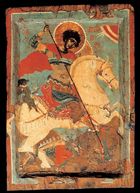|
Recently a family member asked me to provide some artwork for the cover of a forthcoming book, which besides being my first opportunity at a project of this kind presented some interesting technical problems. Gold areas in a design are notoriously difficult to reproduce in print. Every scratch and blemish is magnified in a scan, it comes out looking dull and brown, or gives off unwanted reflections. I decided it would be a waste to include any gold in the design at all. Not that lack cheapens the piece as an icon in any way. In the past, icon painters by no means always used gold in their designs. In times of scarcity or of war, for fresco schemes, for clients with shallower pockets, or sometimes simply for artistic reasons, many icons were painted with coloured backgrounds. Putting aside its symbolical properties, burnished gold acts as neutral in a painting (strangely enough) and also, as a background, makes a motif 'tell up' incredibly well. Also, let's be honest, that amount of bling tends to distract from a multitude of shortcomings in a painting. Icon painters can tend to get very hung up on the quality of their gilding and devote less time to improving the actual painting!
In the end I substituted a painted ground of red for the the medallion of Christ. I added the symbols of the four gospellers afterwards, to complete the piece as an icon, and used brilliant white for the background. White is used in icons to convey the brilliance of uncreated light (think of Christ's robes in icons of the Transfiguration). I would have made life a great deal easier for myself if I had not glazed the red with transparent quinacridone pigment to warm its tone - forgetting that quinacridone is horribly staining and travels everywhere, especially onto pure white backgrounds! The quinacridones are a new addition to the artist's palette, developed by the car industry I am told, and useful as a substitute for carmine and alizarin, which are of suspect lightfastness. It's just too darn messy, though; I think I shall have to retire it from my arsenal. An icon of Christ the Teacher in combination with the Hindu and Buddhist lotus symbol were specifically requested by the author to tie in with the theme of the book, which is a work of comparative theology. I designed the roundel of Christ to appear within the 'O' of the book title, with the eastern lotus symbol and frieze beneath, though no doubt the publisher will rehash my design to his own taste. I believe the book goes to print quite shortly: publisher James Clarke & Co Ltd. The actual icon will be framed (unusual for me, but for purposes of reproduction the board was a lightweight one), and appear for sale on my website in due course. |
The view from my deskCurrent work, places and events, art travel, and interesting snippets about Christian icons, medieval art, manuscript illumination, egg tempera,, gilding, technique and materials. Categories
All
Archives
January 2024
|




 RSS Feed
RSS Feed